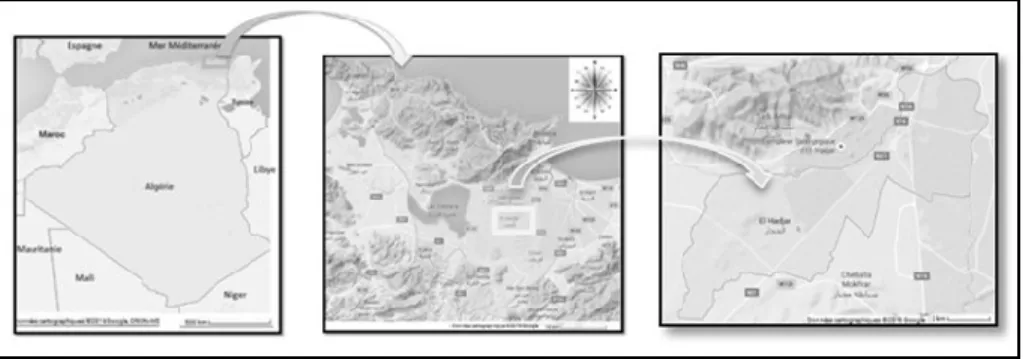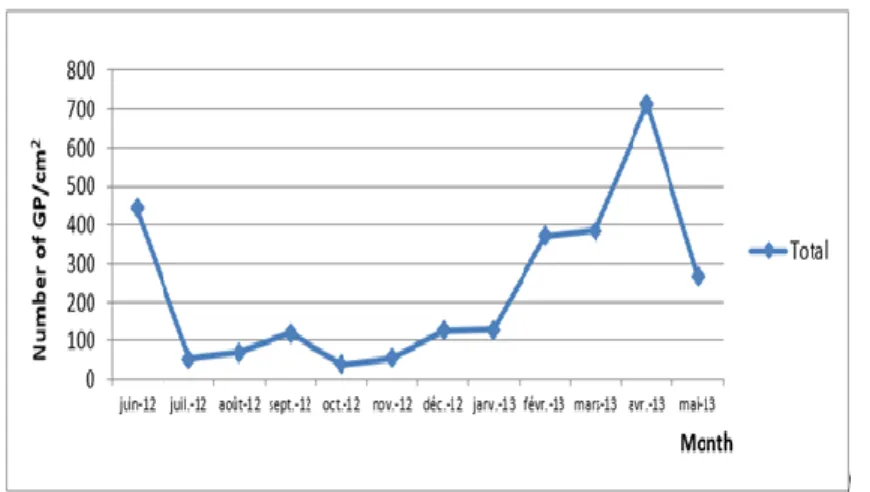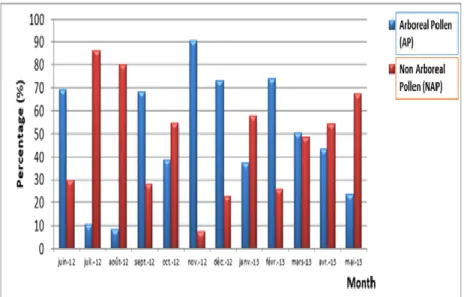Volume 27, Number 2, Pages 126-131 (2018) DOI: 10.1501/commuc_0000000207 ISSN 1303-6025 E-ISSN 2651-3749
http://communications.science.ankara.edu.tr/index.php?series=C
Received by the editors: November 13, 2018; Accepted: December 01, 2018.
Key word and phrases: Aeropalynology, allergenic pollens, atmospheric pollens, El-Hadjar region (Algeria). Submitted via II. Aerobiology and Palynology Symposium 07-10 October 2018 (APAS 2018)
© 2018 Ankara University Communications Faculty of Sciences University of Ankara Series C: Biology THE ALLERGENIC POLLEN IN THE ATMOSPHERE OF
EL-HADJAR CITY (ANNABA, ALGERIA) ASMA NECIB, LARBI BOUGHEDIRI
Abstract. The aeropalynogical study of the atmosphere of El-Hadjar town was carried out during one year, from June 1, 2012 to May 31, 2013. The collected pollen during the sampling period yielded 2729 pollen grains/cm2 belonging to 50 taxa, distributed on 20 families (Apiaceae, Arecaceae, Asteraceae, Boraginaceae, Brassicaceae, Caryophyllaceae, Chenopodiaceae/Amaranthaceae, Cupressaceae, Cyperaceae, Ericaceae, Fabaceae, Lamiaceae, Mimosaceae, Pinaceae, Poaceae, Rosaceae, Scrophulariaceae, Ulmaceae, Urticaceae and Vitaceae.); 24 genera (Alnus, Artemisia, Betula, Borago, Carya, Casuarina, Echium, Ephedra, Eucalyptus, Fraxinus, Juglans, Juncus, Ligustrum, Mercurialis, Melia, Pistacia, Plantago, Platanus, Populus, Quercus, Rumex, Salix, Tilia and Trifolium.) and, 6 species (Castanea sativa, Corylus avellana, Olea europaea, Quercus ilex, Ricinus communis and Typha angustifolia). The pollen peak concentration was recorded in April with 715 GP/cm2 and the minimum value in October with 36.08 GP/cm2. The pollen spectrum has a percentage of 52.31% of pollen tree. The Cupressaceae family contributed with 12.84%, Olea europaea with 6.95%, Eucalyptus and Casuarina with 5.85 and 5.71%. The highest percentage of this type of pollen occurs in November with 90.51%, dominated by Casuarina pollen with 86.31%. The highest concentrations of tree taxa are: Eucalyptus (35.03%) and Ligustrum (16.21%) in June. Fraxinus with 64.64% in December, Ericaceae 17.42% in March; Olea europaea and Quercus in April with 18.86% and 6.79% respectively. The pollens of the herbs present 44.89%. They are characterized by the major presence of Poaceae and Mercurialis pollen with the following percentages: 21.49% and 11.75%. It seems that the months of July (86.33%) and August (80.14%) mark the highest percentages of non-tree pollen.
1. Introduction
According to the classification of the World Health Organization (WHO), allergic diseases are the fourth most common chronic disease. They constitute a public health problem and cause significant morbidity in different countries. Epidemiological studies have shown that the prevalence of allergic diseases and pollen allergy rhinitis is increasing. In the Mediterranean region, pollen-induced
allergic reactions affect more than 10% of the population [1-4].This work aims to
2. Materials And Methods
2.1 Study area
El-Hadjar city is located on the Mediterranean coast at an altitude of 3 m above
sea level, covering an area of 63 km2 of Annaba province (northeast Algeria) (Fig.
1). It is the fourth most populous town in the Wilaya with 37.364 inhabitants [5]. This town exhibits a typical Mediterranean climate; the vegetation of the area is characterized by the presence of various plants including: Poaceae, Salicaceae, Oleaceae, Fagaceae, Urticaceae, Fabaceae, Plantaginaceae, Polygonaceae, Chenopodiaceae/Amaranthaceae, Pinaceae, Cupressaceae, Asteraceae, and Arecaceae [6].
FIGURE 1. Localization of the study area.
2.2 Method of airborne collection
A gravimetric study of the atmosphere was carried out during one year from June 2012 to May 2013, using the Durham apparatus [7] placed in the town center at 4.5 m.
The slides were covered with glycerin jelly mixed with basic fuchsine [8]. After 24 h of exposure, slides were changed for reading with a light microscopy (Carl Zeiss, standard 20) using 40x and 100x magnification.
The pollen grains were identified and counted, identifying at specie, at genus and at family level using pollen Atlas of Reille [9]. The grains that were not identified were considered unidentified types.
3. Results And Discussion
The collected pollen during the sampling period yielded 2729 pollen grains/cm² belonging to 50 taxa, distributed on 20 families (Apiaceae, Arecaceae, Asteraceae, Boraginaceae, Brassicaceae, Caryophyllaceae, Chenopodiaceae/Amaranthaceae, Cupressaceae, Cyperaceae, Ericaceae, Fabaceae, Lamiaceae, Mimosaceae, Pinaceae, Poaceae, Rosaceae, Scrophulariaceae, Ulmaceae, Urticaceae and Vitaceae.); 24 genera (Alnus, Artemisia, Betula, Borago, Carya, Casuarina, Echium, Ephedra, Eucalyptus, Fraxinus, Juglans, Juncus, Ligustrum, Mercurialis, Melia, Pistacia, Plantago, Platanus, Populus, Quercus, Rumex, Salix, Tilia and Trifolium.) and, 6 species (Castanea sativa, Corylus avellana, Olea europaea, Quercus ilex, Ricinus communis and Typha angustifolia).
The Figure 2 indicates that the pollen concentration peak was recorded in April
with 715 GP/cm2 and the lowest value in October with 36.08 GP/cm2.
FIGURE 2. Monthly variation of the number of pollens collected during the pollen season in El-Hadjar city (June 2012-May 2013).
At the beginning of the season, we observed a decline in the number of pollen followed by a small increase from July to September, then another decrease during the month of October.
The number of pollen grains began to increase gradually in November, then in
January, we noted a significant rise from 126.5 to 370 GP/cm2. A second lift was
recorded during the month of March ranging from 380 to 715 GP/cm2. Finally, a
sudden fall takes place in May.
According to figure 3, the pollen spectrum shows a percentage of 52.31% of tree pollen.
FIGURE 3. Monthly variation in the percentage of arborel and non-arborel pollen from collected taxa during the pollen season in El-Hadjar city (June 2012-May 2013).
The Cupressaceae family contributed with 12.84%, Olea europaea with 6.95%, Eucalyptus and Casuarina with 5.85 and 5.71%. The highest percentage of this type of pollen occurs in November with 90.51%, it is particularly pollens of Casuarina with 86.31%. The highest concentrations of tree taxa are: Eucalyptus (35.03%) and Ligustrum (16.21%) in June, Fraxinus with 64.64% in December, Ericaceae 17.42% in March; Olea europaea and Quercus in April with 18.86% and 6.79% respectively. The pollens of the herbs present 44.89%. They are characterized by the major presence of Poaceae and Mercurialis with the
following percentages: 21.49% and 11.75%. It seems that the months of July (86.33%) and August (80.14%) mark the highest percentages of non-tree pollen of Poaceae, Cyperaceae, Mimosaceae, Urticaceae and Chenopodiaceae/ Amaranthaceae.
4. Conclusion
During one year of aerobiological survey of the air of El-Hadjar town, data has shown that the principal allergenic collected taxa were: Brassicaceae,
Chenopodiaceae/Amaranthaceae, Cupressaceae, Mimosaceae, Pinaceae,
Poaceae, Ulmaceae, Urticaceae, Alnus, Artemisia, Betula, Casuarina, Eucalyptus, Fraxinus, Ligustrum, Plantago, Platanus, Populus, Quercus, Rumex, Salix, Olea europaea and, Quercus ilex. It may be a useful data for allergologists as an aid in establishing the exact diagnostics.
References
[1] M. Thibaudon and G. Olivier, Pollinoses et surveillance des pollens en France. Air Pur, 71 (2), (2007) 10-16.
[2] M.C. Kopferschmirt-Kubler and G. Pauli, Pollens et pollution. Revue Francaise d'Allergologie, 39 (4), (1999) 283–288.
[3] G. D’Amato, Pollen allergy in the Mediterranean area. Revue Francaise d'Allergologie, 38 (7), (1998) 160–162.
[4] B. Clot, Impact du réchauffement climatique sur le risque d’exposition aux allergènes environnementaux et aux pollens. Médecine et enfance, (2008) 141–145.
[5] General Directorate of Forestry, La Direction Générale des Forêts de la Wilaya d’Annaba (2013).
[6] L. Ketfi, Etude aéropalynologique de la région d’El-Hadjar. Mémoire de Magister: Université Badji Mokhtar, Annaba. (1998) 123 p.
[7] O. C. Durham, The volumetric incidence of atmospheric allergens. IV. A proposed standard method of gravity sampling, counting and volumetric interpolation of results. Journal of Allergy, 17 (2), (1946) 79–86.
[8] J. Charpin, R. Surinyach, & A.W. Frankland, Atlas of European allergenic pollens. Paris: Ed. Sandoz, (1974) 131–141.
[9] M. Reille, Pollen et spores d’Europe et d’Afrique du (Nord ed.). France: Laboratoire de Botanique Historique et Palynologie. Univ. d’Aix-Marseille III., (1992) 543 p.
Current Address: ASMA NECIB: Department of Biology, Mohamed Cherif Messaadia University, Souk-Ahras, Algeria. Laboratory of Plant Biology and Environment (L.B.V.E), Department of Biology, Faculty of Sciences, Badji Mokhtar University, Annaba, Algeria.
E-mail : a.necib@univ-soukahras.dz; sama.nb@hotmail.com
ORCID: https://orcid.org/0000-0002-3958-9284
Current Address: LARBI BOUGHEDIRI: Laboratory of Plant Biology and Environment (L.B.V.E), Department of Biology, Faculty of Sciences, Badji Mokhtar University, Annaba, Algeria.
E-mail : lboughediri@yahoo.com


